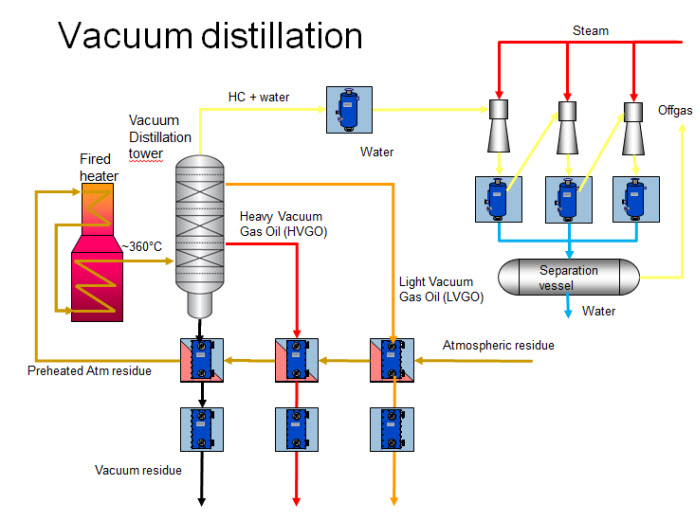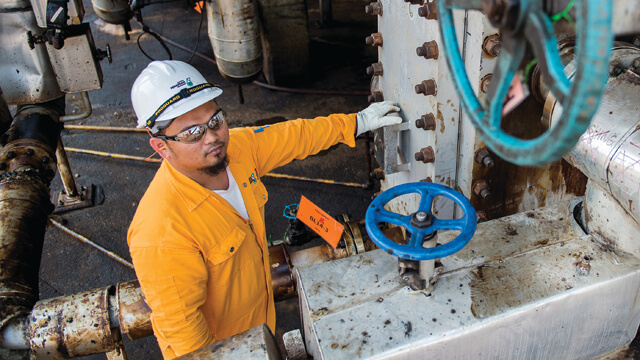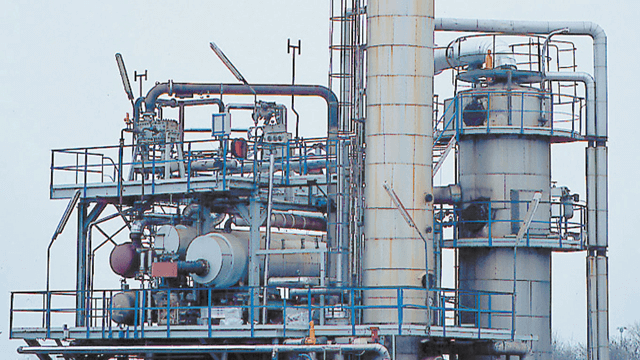Vacuum distillation
Recovering additional distillates from atmospheric residue maximizes refinery profitability. Which is why highly reliable, energy-efficient vacuum distillation processes are critical. Whether using a stand-alone vacuum distillation unit or one integrated with an atmospheric distillation unit, count on reliable Alfa Laval compact heat exchangers to optimize energy efficiency and uptime.
Optimizing refinery vacuum distillation processes
Using a stand-alone vacuum distillation unit or one integrated with an atmospheric distillation unit will be beneficial to the refinery in terms of producing more valuable products from the atmospheric residue. Alfa Laval has the expertise, technologies and services to contribute to reliability, energy savings, less maintenance, reduced costs and increased production.
Increasing energy efficiency in vacuum distillation processes
A typical preheat train using traditional shell-and-tube heat exchangers, is based on a pinch/overall temperature approach of approximately 40°C. This takes into account practical limitations, such as heat transfer area required, space limitations, installed costs, hydraulic limitations and operating performance.
Plate heat exchangers, on the other hand, have an optimal pinch of 10°C, which means that up to 25% more energy can be recovered from the hot fractions and used to preheat the feed. This also results in a 25 % energy savings in the fired heater.
Using compact heat exchangers, such as the Alfa Laval Compabloc, also makes it possible to recover energy more efficiently from the hot fractions for steam generation. Because Compabloc heat exchangers can generate steam with a much closer temperature approach than shell-and-tubes, it is possible to optimize the steam generation:
- To generate steam at a higher pressure, or
- To generate more steam at a fixed pressure, or
- To generate same amount and quality of steam but from an energy source of lower grade
Fouling mitigation in vacuum distillation
Traditional shell-and-tube heat exchangers normally experience fouling problems. Fouling usually occurs in the hot end of the preheat train where residue is used as the heating media, and temperatures are high and velocities low. Fouling is very costly and increases energy consumption in the fired heater and feed pump power consumption over time. It also can limit production if the maximum capacity of the fired heater of the feed pump capacity has been reached. This means that the heat exchangers need frequent cleaning, which affects the overall performance of the plant.
To minimize chemical deposition fouling, Alfa Laval Compabloc heat exchangers are designed with high turbulence and shear stress in the heat transfer channels. This results in a much longer run length – typically up to three times longer – than shell-and-tube heat exchangers.
Because Alfa Laval Compabloc heat exchangers provide high heat transfer efficiency, fewer exchangers are needed for each service. What’s more, our heat exchangers are designed for easy access and fast, effective mechanical cleaning of the heat transfer area, which minimimzes maintenance costs.
CAPEX savings for vacuum distillation
The number and size of traditional shell-and-tube heat exchangers required for vacuum distillation increase as the amount of energy recovered from the hot fractions into the feed increases.
In addition, when handling highly viscous media such as when heating cold atmospheric residue or final cooling of the vacuum residue, shell-and-tube exchangers prove to be very inefficient. It then becomes necessary to install several large exchangers that have high fouling tendencies and high maintenance requirements in series.
With high-efficiency Alfa Laval Compabloc heat exchangers, no more than two units are generally required for each service, no matter the degree of heat recovery or fluid viscosity. These units require three to five times less heat transfer area than comparable shell-and-tubes due to the high heat transfer efficiency and the use of thin heat transfer plates that further reduce the amount of material used.
By minimizing the number of exchangers and the heat transfer material required, the costs of the exchanger itself as well as its installation are drastically reduced. This is especially true when higher grade material is needed for high corrosion resistance. It is possible to achieve cost reductions of up to 80%.
For revamp projects, payback generally takes anywhere from a few months or, at most, two years, depending on the project’s complexity.
In addition, by maximizing the heat recovery in the preheat train, the investment costs in fired heater capacity can also be minimized. Likewise, by minimizing the overall pressure drop in the preheat train, the feed pump capacity and head can be reduced, which can also reduce the design pressure limits of all equipment in the preheat train.
Finally, because our Compabloc exchangers can be designed with a very close temperature approach, it is possible to optimize the temperature of the water in the tempered water cooling loop. This minimizes the cost of other equipment, such as tempered water air coolers.
Proven technology for refinery vacuum distillation
Alfa Laval has more than 200 compact heat exchangers operating in vacuum distillation processes around the world. Most of our exchangers are installed around the pinch or at the end of the preheat train, just before the furnace. However, Alfa Laval compact heat exchangers can also be used as overhead vacuum condensers, steam generators and residue final coolers. There are also preheat trains where every single heat recovery position uses an Alfa Laval Compabloc exchanger.



